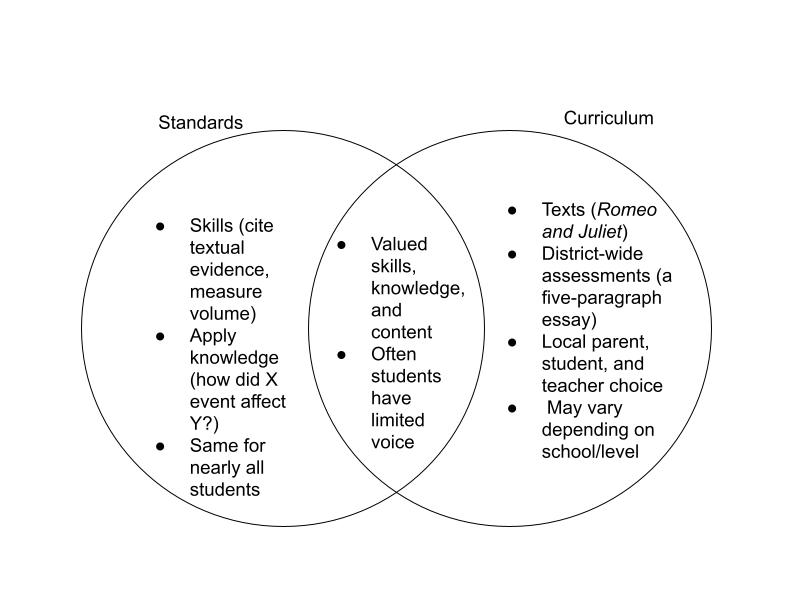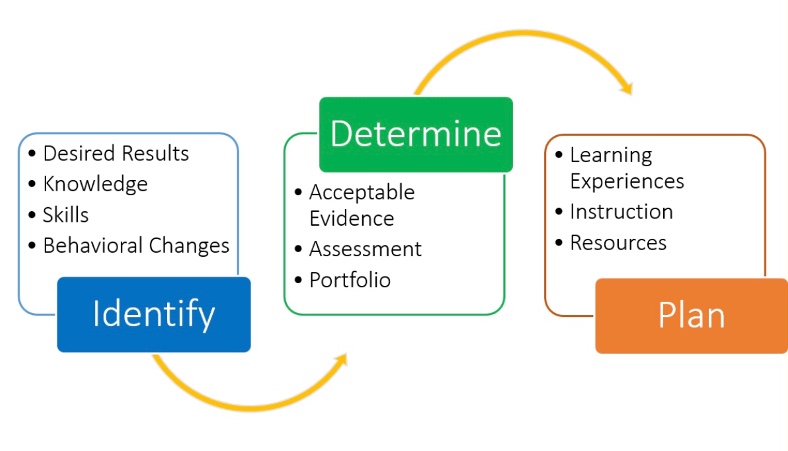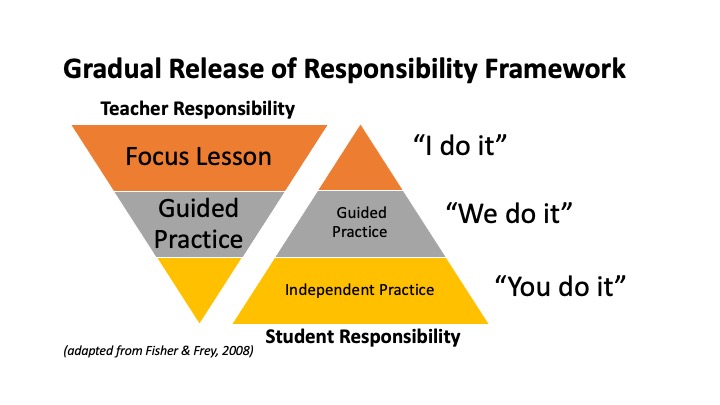11
A substitute teacher was supposed to give an assessment while the classroom teacher was away, but one student refused to take the test. “He started yelling and walked out of the room, saying he wasn’t going to take this test that the teacher left for him. He kept saying that he is supposed to have questions read aloud to him, but that isn’t fair and I wasn’t going to do it!” Sometimes we think that fairness means everyone is treated the same way, but in reality, “fairness” involves meeting the needs of different students. In this example, the student had an IEP(individualized Education Plan) accommodation that allowed him to have tests read aloud to him. When considering instruction, and assessment, sometimes treating all students the same is actually quite unfair, since students have different learning needs and strengths.
In this chapter, we will begin to explore the standards and planning for instruction.
Chapter Outline
Effective teachers must plan effective lessons, which are based on standards. Standards vary depending on the state where you teach. Standards tell teachers the key information that students should understand in specific content areas at varying grade levels. As a teacher, you are responsible for knowing the standards you are responsible for teaching and planning effective lessons to help students learn the information explained in the standards. An elementary school teacher is responsible for standards in English, math, science, and social studies; a secondary teacher typically specializes in one area, such as history. There are also standards for fine arts, languages, and other areas.
Some states use state-developed standards, while other states adopted the Common Core State Standards[1]. These standards have been an attempt to move the nation closer to a unified set of standards. As of 2021, 41 states, the District of Columbia, four territories, and the Department of Defense Education Activity (DoDEA) have adopted them, with varying degrees of implementation and support at the district levels (Common Core States Standards Initiative, 2021).
It is not uncommon to hear a teacher or parent say that they want schools to “cover” curriculum or standards; however, “coverage” is not conducive to deep understanding. Instead, a teacher should review the standards and local curriculum as a part of their planning, with a focus on big, transferable ideas (Wiggins & McTighe, 2005). This is considered depth of material, rather than simply breadth of material.
Standards and curriculum are not the same thing. Standards tell you what to teach; curriculum (and corresponding methods) tells you how to teach. Figure 6.1 compares and contrasts standards and curriculum.
Figure 6.1: A Comparison of Standards and Curriculum

Planning

Sometimes your school or district will provide lesson plans for you, but more often, you will have the autonomy to make your own lesson plans. Teachers may be part of a Professional Learning Community (PLC) with other teachers in the same grade or content area. During these PLCs, teachers plan together and often look at student assessment data to determine what to further emphasize for students or teach in a different way. They may also have a common book or article to read in the field of education to expand their knowledge of teaching and learning. A teacher of a “special” area or elective subject like music or art might occasionally meet with teachers in other local schools to share information and discuss curriculum, lessons, or assessments. Working with others in planning is a critical skill to learn as a teacher.
One of the most effective planning strategies is Backward Design (Wiggins & McTighe, 2005). Figure 6.2 depicts a backward design planning process. While it is common for new or inexperienced teachers to focus on “filling the time,” or “what” they will teach, backward design involves following these steps:
- Identifying the desired goals and objectives;
- Determining acceptable evidence and assessments; and
- Planning instruction (Wiggins & McTighe, 2005).
This does not mean that a teacher will have the exact final assessment ready before the first day of instruction; however, teachers should have a clear idea of the format of the assessment and know what kinds of questions and content will be on it.
Figure 6.2: Backward Design Process

Critical Lens: Homework
We all have had homework during our K-12 schooling. You may have had it as early as kindergarten. There is debate about whether or not schools should even give homework, especially for a grade. Why? It comes down to issues of equity. If a family member is not available to help or is not fluent in the language of instruction, then the student has less of a chance to accurately complete a homework assignment. Since homework is often factored into grades, this can negatively impact students without additional resources. What is also important to remember as teachers is that homework should never be new material: it should always be a review and reinforcement of instruction that has already been provided. Listen to the “Is It Time to Ban Homework?“[2] podcast from Trending in Education to learn more.
Lesson Plan Components and Models
Lesson planning is a key component to any effective instruction. Experienced teachers do not usually script their lesson plans; however, many districts will ask even seasoned teachers to turn in lesson plans for the week or month. All lesson plans will contain similar elements, sometimes in a different order.
- Standards: Select the specific standards you will teach in this particular lesson. Note that you will often choose one sub-standard, or piece, of a standard to teach, and it may take multiple lessons for students to master the content.
- Objectives: State what students will know, understand, and do by the end of the lesson. Objectives can be phrased as “The student will…” or, from a student perspective, “I can…”. Content objectives should directly relate to the standards, and language objectives should be included for English Learners.
- Materials: List all materials, such as books, resources, tools, websites, and other items that will be used for the lesson. This assists you with gathering materials so you are prepared to teach the lesson.
- Procedures: Break down the lesson into specific steps you will follow. Think of it as programming: you must provide simple, clear steps to achieve the lesson’s instructional goals.
- Differentiation: Consider how you will adapt your lesson to meet the needs of specific types of learners. For example, how will you support your English Learners, challenge your students who are gifted, or enable a student who struggles with spelling to participate without getting frustrated? Sometimes you may design a lesson around a Universal Design for Learning (UDL) framework, which means you’ve built these considerations into the plan and do not need to retrofit differentiation strategies later.
- Assessment: Explain how you will measure students’ progress toward lesson objectives and mastery of selected standards. Make sure you are collecting tangible evidence. .

CONCLUSION
This chapter outlines effective methods of instructional planning, but other methods exist in the world. You may have observed a teacher teach differently, perhaps more spontaneously, and enjoyed the experience. Keep in mind that all students are not the same. What worked for you or your family or friends is likely not the best or only way that teaching should be done. Teaching is challenging, complicated work, but with a solid understanding of curriculum, planning, assessment, and instruction, teachers are prepared to reach all students and move them to the next level of knowledge, skill, and understanding.
Local model of professional development in which teachers, often in the same grade level or content area, come together to plan, analyze assessment data, read a book/article, or engage in other professional development activities.
Planning concept designed by Wiggins & McTighe (1998) that involves identifying desired results and then working backward to design assessment and instruction.
Formal documents telling teachers the key information that students should understand in specific content areas at varying grade levels.
Statement of what students will know, understand, and do by the end of the lesson.
Portion of a lesson plan in which all materials, such as books, resources, tools, websites, and other items that will be used for the lesson, are listed.
Portion of a lesson plan that breaks down the lesson into specific steps the teacher will follow.
Portion of a lesson plan that considers any necessary adaptations to meet the needs of specific learners, such as English Language Learners.
Framework for instructional design to meet the needs of all learners in which teachers develop lessons around three core concepts that support accessibility: engagement, representation, and expression.
Component of a lesson in which the teacher measures a student's understanding using varying techniques.
